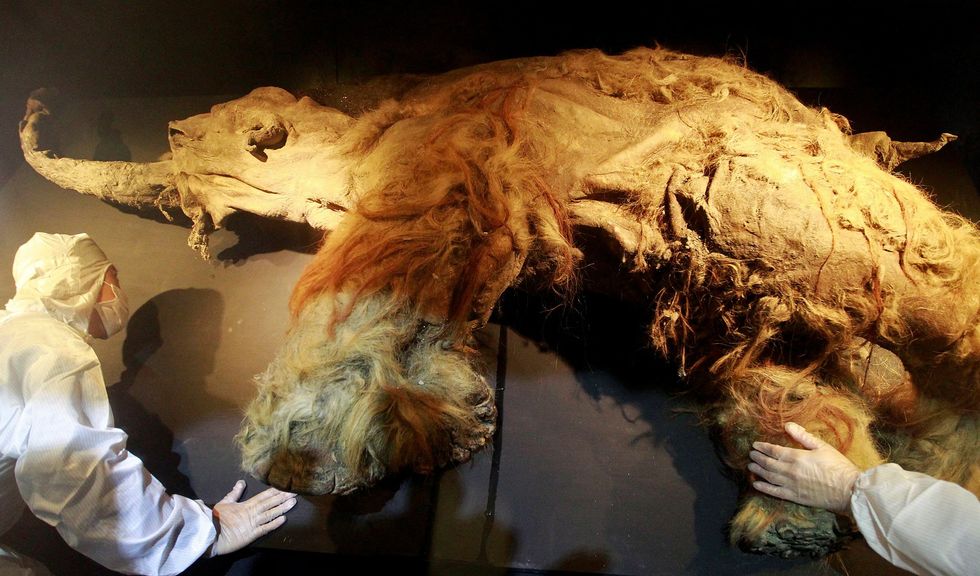Ancient species now a 'step closer to de-extinction' after discovery of 40,000-year-old molecule

The mammoth's RNA molecules were found in Siberian permafrost
Don't Miss
Most Read
Scientists have successfully extracted RNA molecules from a woolly mammoth frozen for nearly 40,000 years.
The discovery marks a breakthrough that researchers say could advance efforts to resurrect extinct species, as it represents the world's oldest RNA ever recovered.
Experts suggested the findings in Siberian permafrost could provide essential knowledge for de-extinction projects targeting mammoths and potentially other vanished creatures like the dodo and Tasmanian tiger.
"Our methods and results could indeed inform and help the efforts aimed at 'de-extincting' certain renowned animals," Dr Emilio Mármol from Copenhagen's Globe Institute told the Daily Mail.
The achievement challenges scientific understanding about RNA preservation, as the molecule typically breaks down within hours of death according to conventional wisdom.
The remarkable preservation occurred in a specimen called Yuka, unearthed by the Yukagir community in 2010 from melting permafrost near the Arctic Ocean.
The juvenile mammoth, estimated to be between five and ten years old when it perished, was discovered on a bluff in north-eastern Siberia with strawberry blonde fur and partially mummified flesh that remained pink until excavation.
Swedish and Danish researchers managed to isolate RNA from one of Yuka's legs, achieving what many considered impossible given the molecule's notorious instability.

Valeri Plotnikov with his collection of tusks
|GETTY
"It's so amazingly surprising to find RNA that is 40,000 years old. Nobody really thought this was possible," said Marc Friedländer, a computational biologist at Stockholm University.
The previous oldest RNA came from a Siberian wolf or dog puppy preserved for 14,300 years, making Yuka's genetic material nearly three times older.
The ancient RNA revealed active genes related to muscle function and metabolic stress responses at the time of death, providing an unprecedented glimpse into the mammoth's final moments.
Evidence suggests Yuka suffered trauma before dying, with deep scratches on its hindquarters indicating a possible cave lion attack, though researchers remain uncertain about the exact cause of death.
LATEST DEVELOPMENTS

People in protective suits examine a frozen woolly mammoth from Siberia named "Yuka"
|REUTERS
"We found that there were stress genes that were being active," Friedländer explained, noting the muscle tissue showed signs of significant strain.
Perhaps most surprisingly, RNA and DNA analysis revealed that Yuka was male, overturning the initial assessment made when the specimen was discovered.
"I have been around long enough to know that these things happen," said Love Dalén from Stockholm University, explaining that incomplete preservation made visual identification difficult.
The breakthrough extends beyond mammoth biology, with researchers identifying previously unknown microRNA molecules unique to the extinct species.

The discovery has garnered global interest
|REUTERS
"These microRNAs are completely new to science and probably only expressed in mammoths, or at most in modern elephants," Dr Mármol told the Daily Mail.
Scientists believe the technology could prove vital for understanding how specific mammoth characteristics, such as their distinctive woolly coat, were genetically regulated.
"RNA profiles from mammoths could in the future tell us how certain traits, like mammoth hair, were controlled genetically," Dalén noted.
The research team also anticipates broader applications, particularly in studying prehistoric pathogens.
"There are, for example, some Pleistocene bird carcasses that would be really interesting to investigate with regards to bird influenza," Dalén suggested.
Meanwhile other researchers highlighted potential insights into the evolution of RNA viruses including coronaviruses and Ebola.











